How Much Do You Really Know About First Aid in the Office?
- First aid at work
- Office risk audit
- First aid needs assessment for offices – step-by-step guide
- First aid at work training
- First aid box contents for offices
- First aid rooms
- First aid record keeping
- First aid signage and information
- Summary of the key points in this guide
- First aid in the office – frequently asked questions
How Much Do You Really Know About First Aid in the Office?
Reading time: 16 minutes.
What you need to know
The Health and Safety Executive (HSE) Labour Force Survey in 2017/18 found that there were an estimated 555,000 non-fatal self-reported injuries to people at work, so first aid kits in the workplace are essential.

The Health and Safety (First Aid) Regulations says that employers must provide ‘adequate and appropriate’ equipment, facilities and personnel so that their employees can receive immediate attention if they are injured or taken ill at work.
As an employer, you must decide what the appropriate arrangements for first aid should be by assessing your workplace, activities, employees and risks. This will allow you to decide whether you will need trained first aiders, what should be included in your first aid kit(s) and if a first aid room is needed.
There aren’t any hard and fast rules about how you should carry out your assessment, but normally you should look at the size of your organisation and its sites, how many people you employ and how they work. You will need to think about the different types of hazards in each of your locations to put the right measures in place.
You should also check the distance emergency services must travel to reach your location and how long it might take, how many trained first aiders you will need and what cover will be required if they are absent.
The St John Ambulance online first aid requirements calculator can help you to make a start.
In a low-risk workplace such as a small office you should have at least a first aid box and someone appointed to manage your first aid arrangements. You must also give your employees information about the first aid arrangements you have put in place.
If your assessment identifies more significant health and safety risks, you might need trained first aiders and a first aid room.
What happens if you don’t have proper arrangements to provide first aid in your offices
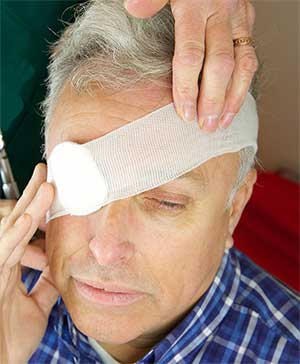
In the worst case, someone could die or suffer serious harm if you haven’t made the proper arrangements for first aid. Breaches of the Regulations will be dealt with proportionately and the penalties can include enforcement action and prosecution.
Enforcement action could include issuing an improvement, prohibition or enforcement notice. The HSE will prosecute where there is significant risk, where established standards have not been followed or you have regularly failed to meet your legal obligations.
Under the Health and Safety at Work Act you can receive an unlimited fine, imprisonment for up to two years or both, and you might also have to pay compensation for personal injury, loss or damage. You could receive a community sentence or be disqualified from activities related to the management of the company where the offence took place.
What you will learn from this guide
First aid in your offices could save a life, so making sure you have the right equipment, supplies and trained people in place is important.
So that your employees can receive immediate attention if they are injured or taken ill at work you will need to complete a first aid needs assessment.
You will find a step-by-step guide to help you decide what will be ‘adequate and appropriate’ arrangements for your offices.
For very low risk office environments, you will need to find out more about the role of the person appointed to be responsible for your office first aid kit, and calling the emergency services if needed.
If some additional risks due to your working environment are identified such as: the way some of your employees work, or specific needs of some employees, then you will need to find out more about the training, extra first aid supplies and facilities that could be needed.
First aid at work
If you are an employer, the first aid Regulations say you must make arrangements for the immediate care of any member of your staff who has an accident or becomes ill at work.
To do this adequately and appropriately you must:
- assess your first aid needs based on the hazards and risks involved in your office
- provide appropriate equipment and enough trained first aiders to help anyone who is injured or ill at work.
You aren’t required to include non-employees such as members of the public but the HSE recommends that they are included in your assessment of first aid needs and the arrangements you make.
Office first aid requirements
While offices aren’t normally thought of as dangerous places to work there are risks in every workplace. Because offices feel safe both employers and employees might not be as focussed on first aid as in some other riskier environments.
In every workplace it’s important to know who the first aiders are, where the first aid kit can be found and what to do if someone is taken ill or is injured at work.
In an office, someone could be injured carrying a heavy box of files or cut themselves using a knife or scissors. They might even receive an electric shock from faulty equipment or a burn from a hot kettle. It’s important to be prepared in case someone has an allergic reaction or is suddenly taken ill.
Because office-based activities don’t normally pose significant risks, a designated first aider might not be required. However, your employees will still need to know what to do if first aid is needed. This might include training in cardiopulmonary resuscitation (CPR) or how to put someone in the recovery position.
At least one person, known as an ‘appointed person’ will be needed. They will be responsible for looking after the contents of your first aid kit and calling the emergency services if needed.
Office first aid and the law
As an employer you must be able to respond to accidents, injuries and illnesses at work by providing:
- adequate equipment
- first aid facilities
- trained personnel.
This applies to all sizes of business and self-employed people too.
The HSE provides guidelines but, as the employer, you must decide what’s appropriate. If your first aid arrangements aren’t adequate the penalties can be severe.
If you're self-employed, you are responsible for making appropriate first aid arrangements for your working environment. If you work with other self-employed people, you are each responsible for making your own first aid arrangements, but you can do this together. If you do, the HSE recommends that you have a written agreement in place.
Back to indexOffice risk audit
The HSE has an online tool to help you assess risks in office-based environments in around 20 minutes.
It allows you to produce a tailored assessment by selecting the relevant hazards and thinking about how you can control them.
You can do the assessment with an anonymous account if you wish. If you sign up with your email address, you'll receive a reminder to check and update your assessment in 12 months.
Back to indexFirst aid needs assessment for offices – step-by-step guide
To understand what first aid equipment, facilities and personnel you need to provide, your first aid needs assessment should include:
- the work you do as well as workplace hazards and risks
- who you employ and any special needs
- your organisation’s history of accidents
- the size of your organisation
- where people work
- any special requirements for travelling, remote or lone workers
- work patterns
- the remoteness of your site from emergency medical services
- employees working on shared or multi-occupied sites
- annual leave and other absences of first aiders and appointed persons
- first aid provision for non-employees.
If you are self-employed you should still have appropriate equipment to provide first aid to yourself at work.
You don’t have to record the findings of your first aid needs assessment, but it will be helpful to show how you have made decisions about the first aid arrangements you provide.
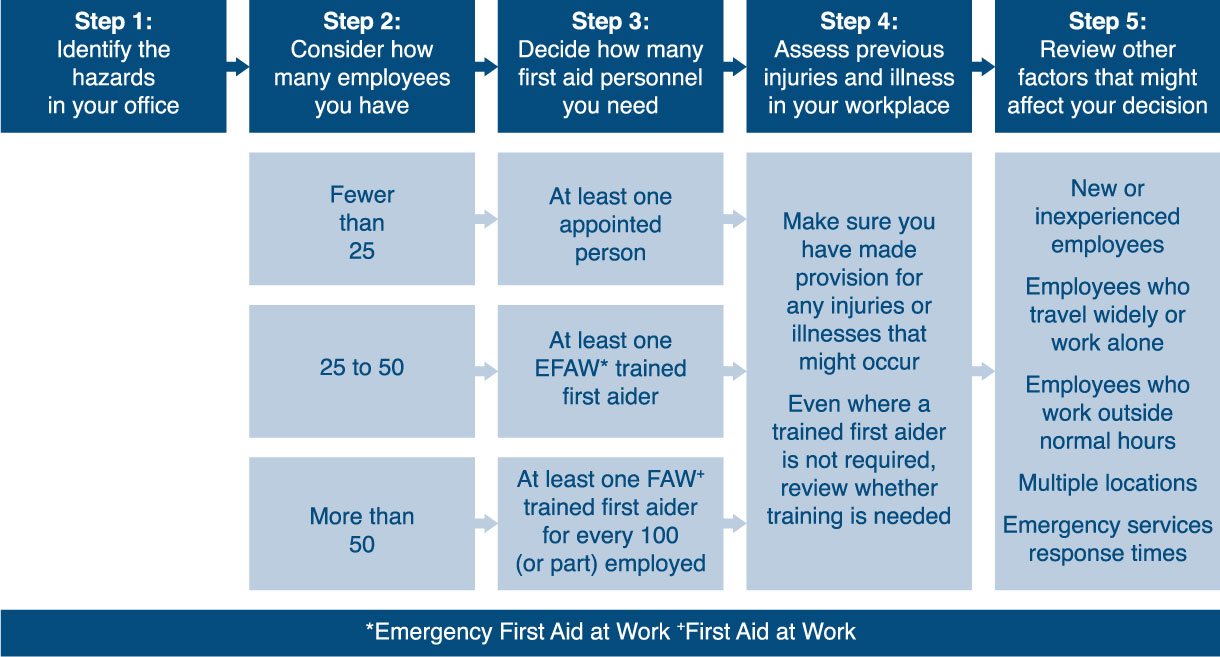
Low-hazard activities - if you carry out activities in your own home involving low hazards, such as clerical work, you would not be expected to provide first aid equipment beyond your normal household needs.
Travelling - if your employees’ work involves driving long distances or they are continuously on the road, your assessment might indicate that personal first aid kits should be kept in their vehicles.
Trained first aiders - if your workplace has more significant health and safety risks, including use of machinery or hazardous materials, you are likely to need a trained first aider.
First aid needs assessment checklist
The HSE offers guidance which includes an optional four-layer framework for first aid. The framework will help you to identify your requirements for:
- an appointed person (AP)
- emergency first aid at work (EFAW) training
- first aid at work (FAW) training
- additional training.
You can use our first aid needs assessment for the office checklist to review your position.
First aid appointed person
If a trained first aider isn’t indicated in your needs assessment, then the minimum requirement is to appoint a person to take charge of your first aid arrangements. Although the person you appoint doesn’t have to receive any formal training, they should only provide first aid if they are properly trained.
The role of your appointed person includes looking after your first aid equipment and facilities and calling the emergency services if needed. If they are competent, they can provide emergency cover when a first aider is absent due to unforeseen circumstances rather than annual leave.
First aid officer’s duties
A first aider is someone who has received training appropriate to the level identified in your first aid needs assessment. This might be first aid at work (FAW), emergency first aid at work (EFAW) or other appropriate first aid training.
Your first aid needs assessment will identify what type of training is needed.
EFAW - training enables a first aider to give emergency first aid to someone who is injured or becomes ill at work.
FAW - this training includes EFAW and first aid for a range of specific injuries and illnesses.
First aid and medication
First aid at work doesn’t include giving medicines or tablets. Medicines aren’t recommended for your first aid box.
The only exception is aspirin, which is given to someone who has had a suspected heart attack.This is currently an accepted first aid practice.
Some employees might have their own prescribed medication (such as an inhaler for asthma). If someone needs to take their own prescribed medication, your first aider can help them to take it and contact the emergency services if necessary.
However, some medicines can be administered to save lives in an emergency, such as adrenaline if someone has a severe allergic reaction (anaphylaxis). If your first aid needs assessment indicates that this might be necessary, you should consider providing your first aiders with additional training for their use.
Mental health first aid
You might include how you will identify and understand the symptoms of employees experiencing mental health difficulties.
Managing mental ill health in your workplace in ways that are appropriate for your business is just as important as physical injury or illness.
Your arrangements might include providing information or training for managers and employees, employee support programmes, taking advice from occupational health professionals, and appointing trained mental health first aiders.
First aid training courses covering mental health will show your employees how to recognise warning signs of mental ill health and help them to develop the skills and confidence to approach and support someone, while keeping themselves safe.
The HSE provides further information on managing workplace stress and mental health issues.
Role of a first aid officer in an emergency
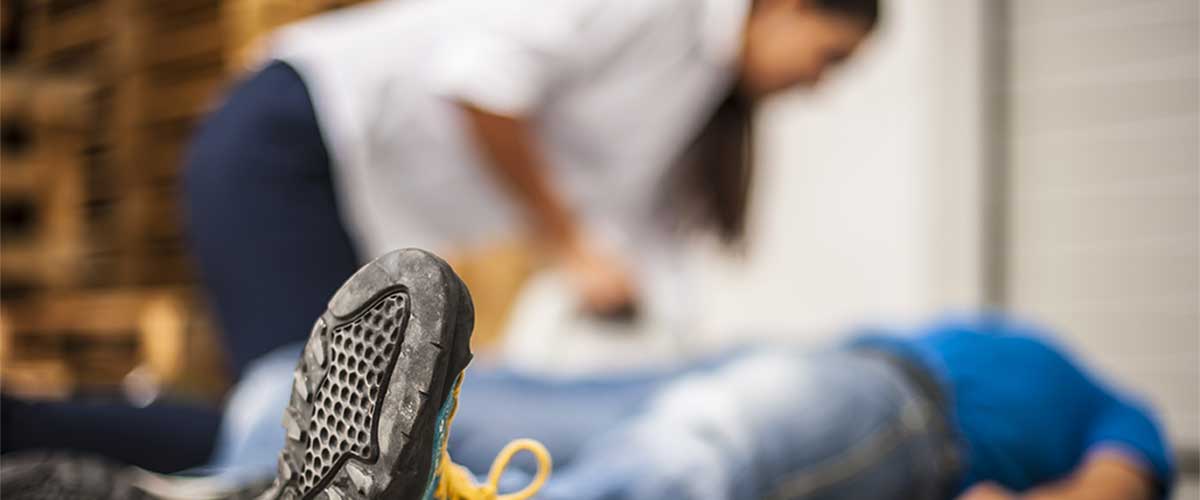
First aid could save a life in an emergency. The role of a first aider is to provide immediate care before further medical help arrives. This could include performing procedures such as:
- placing a casualty into the recovery position
- performing cardiopulmonary resuscitation (CPR)
- using an automated external defibrillator (AED)
- stopping bleeding using pressure and elevation
- keeping a fractured limb still.
The aims are to preserve life, to prevent the patient’s condition becoming worse and to promote recovery.
A first aider should:
- manage the emergency situation to ensure the safety of themselves, bystanders and the affected person
- assess the nature and cause of the injuries or illness
- arrange for further medical help and any other emergency services
- prioritise casualties based upon medical need, if trained to do so
- provide appropriate first aid treatment according to their training
- if possible, make notes and observations
- handover to medical help when it arrives.
First aid at work training
First aid training must meet the required standard. In 2013 the regulations were updated and the HSE no longer approves first aid training and qualifications, although it does provide guidance to help employers choose training providers.
Back to indexFirst aid box contents for offices
There is a British Standard for first aid kits, although you aren’t required to buy kits that meet this standard. The contents of your first aid box will depend on your first aid needs assessment, taking into account the level of hazards, your workplace environment and number of employees.
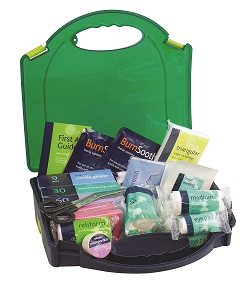
A basic workplace first aid kit suitable for offices will normally include:
- plasters to be used for small cuts and grazes
- gels for burns
- sterile dressings to apply pressure to larger wounds and to help stop bleeding
- bandages to support joints, hold dressings in place, put pressure on wounds or stop swelling
- disposable gloves to reduce the risk of infection
- face shields or pocket masks to prevent infection when you give rescue breaths
- alcohol free wipes to clean the skin around a wound
- adhesive tape to hold dressings or the loose end of a bandage in place
- scissors to cut bandages, sticky tape or someone’s clothing.
You might also include:
- foil blankets to help retain body heat if someone is in shock or at risk of becoming chilled
- sterile eye pads.
A leaflet on general first aid should also be available.
Replacing office first aid supplies
Many items in your office first aid kit will have expiry dates. These are often three to five years after their manufacture. Your supplies can also be damaged due to moisture or exposure to the air, so it’s important to regularly review the contents of your first aid kit and to restock supplies that have been used or damaged and to replace out of date items. You should also check the condition of the container and replace that too, if it’s damaged.
Sterile dressings and bandages don’t typically have expiry dates but if they have been opened or damaged they won’t be considered sterile anymore and should be replaced.
Back to indexFirst aid rooms
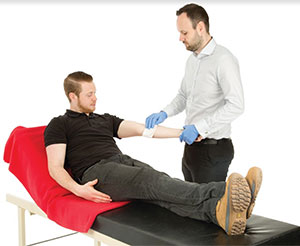
First aid rooms are normally needed in higher risk environments, but if your first aid needs assessment indicates that one is needed it will normally include:
- first aid signs and the first aiders’ names, locations and how to contact them
- a sink with hot and cold running water
- drinking water and disposable cups
- soap and paper towels
- a store for first aid materials and a portable first aid kit
- foot-operated refuse containers, lined with yellow, disposable clinical waste bags or a container suitable for the safe disposal of clinical waste
- an examination or medical couch with waterproof protection and clean pillows and blankets
- a chair
- a telephone
- a record book for incidents attended by a first aider or appointed person.
If possible, the room should be used only for first aid and someone should be responsible for maintaining it and supervising its use. The room should be easily accessible for stretchers and clearly signposted.
Back to indexFirst aid record keeping
Ideally, you should provide your first aiders and ‘appointed persons’ with a book to record incidents. The information can help you to identify accident trends and possible areas for improvement. The record book is not the same as the statutory accident book, although the two could be combined.
These records can be used in future first aid needs assessments and employers, self-employed people and those in control of premises have a duty to report some accidents and incidents at work.
What should be recorded - useful information includes:
- the date, time and place of the incident
- the name and job of the person affected
- details of the injury or illness and the first aid provided
- details about what happened to the person immediately afterwards, for example whether they went back to work, went home, or went to hospital
- the name and signature of the first aider or another person who dealt with the incident.
The person who looks after the book will normally complete this information, but as the employer, you will have overall responsibility.
Back to indexFirst aid signage and information
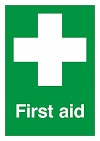
First aid boxes should have a white cross on a green background and first aid rooms should be easily identifiable by white lettering or a white cross on a green background. Signs should be placed where they can be easily seen.
First aid posters are helpful in the workplace to promote awareness and provide reminders of first aid procedures and what to do in the event of an emergency.
There are a number of options from which to choose, such as emergency resuscitation information and guidance on what to do about eye injuries, shock and burns.
Back to indexSummary of the key points in this guide
- First aid at work can save lives and help to protect your employees from serious harm.
- You are required to provide ‘adequate and appropriate’ equipment, facilities and personnel so that employees can receive immediate attention if they are injured or taken ill at work.
- Penalties under the Health and Safety at Work Act can be severe if you don’t make proper first aid arrangements.
- To put the right arrangements in place you will need to complete a first aid needs assessment.
- You are encouraged to include members of the public and mental health first aid in your assessment.
- The minimum requirement in your office is to have an appointed person who is responsible for first aid, who will regularly check and replace the contents of your first aid kit and call the emergency services if needed.
- If your first aid needs assessment highlights additional first aid requirements you might also need to provide first aid training, extra supplies in your first aid kit and a first aid room.
- You must give your employees information about the first aid arrangements you have put in place.
- It must be easy to locate first aid supplies, equipment and personnel, so signage is important.
- Ideally, you should review your first aid needs assessment every year.
- Your trained first aiders should receive refresher training every year and re-qualify every three years.
First aid in the office - frequently asked questions
Do I need to make first aid provision for members of the public?
Employers aren’t required to provide first aid for members of the public, but the HSE strongly recommends that they are considered in first aid assessment and make provisions for them.
How many first aiders do I need?
The findings of your first aid needs assessment will help you decide how many first aiders you will need. You should take into account all the relevant circumstances of your workplace and have enough people to cover holidays, illness or other unexpected absences.
Can legal action be taken against first aiders?
It is very unlikely that any action would be taken against a first aider using the first aid training they have received. It is recommended that you obtain legal advice and contact your insurance brokers to find out whether your policies cover first aiders’ liability.
How often do first aiders need to re-qualify?
First aiders should receive refresher training every year and re-qualify at least every three years. If they don’t refresh their training:
- the HSE will no longer consider them competent to act as a first aider
- they will not be counted towards the required number of first aiders in your workplace.
First aiders can re-qualify by completing a first aid at work requalification course. If their qualification has already expired, they should complete the full training again.
